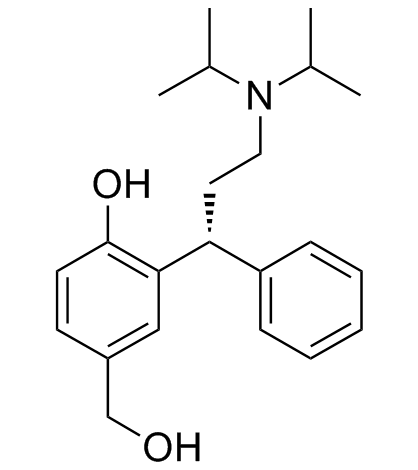Desfesoterodine |
| Catalog No.GC35842 |
La desfésotérodine (PNU-200577) est un antagoniste puissant et sélectif des récepteurs muscariniques (mAChR) avec un KB et un pA2 de 0,84 nM et 9,14, respectivement .
Products are for research use only. Not for human use. We do not sell to patients.

Cas No.: 207679-81-0
Sample solution is provided at 25 µL, 10mM.
Desfesoterodine (PNU-200577; Desfesoterodine) is a potent and selective muscarinic receptor antagonist with a Kb and a pA2 of 0.84 nM and 9.14, respectively. Kb: 0.84 nM (mAChR)[1].
Desfesoterodine (PNU-200577; Desfesoterodine) is a major pharmacologically active metabolite of tolterodine. In vitro, Desfesoterodine (PNU-200577; Desfesoterodine) prevented carbachol-induced contraction of guinea-pig isolated urinary bladder strips in a competitive and concentration-dependent manner. In vivo, Desfesoterodine (PNU-200577; Desfesoterodine) was significantly more potent at suppressing acetylcholine-induced urinary bladder contraction than electrically induced salivation in the anaesthetised cat (ID50=15 and 40 nmol/kg, respectively). In radioligand binding studies carried out in homogenates of guinea-pig tissues and Chinese hamster ovary cell lines expressing human muscarinic m1-m5 receptors, Desfesoterodine (PNU-200577; Desfesoterodine) was not selective for any muscarinic receptor subtype. Thus, Desfesoterodine (PNU-200577; Desfesoterodine) is similar to tolterodine in terms of antimuscarinic potency, functional selectivity for the urinary bladder in vivo and absence of selectivity for muscarinic receptor subtypes in vitro. The results of this study clearly indicate that (R)-5-Hydroxymethyl Tolterodine contributes to the therapeutic action of tolterodine, in view of its high antimuscarinic potency, similar serum concentration and lower degree of protein binding.
[1]. Nilvebrant L, Gillberg PG, Sparf B. Antimuscarinic potency and bladder selectivity of PNU-200577, a major metabolite of tolterodine. Pharmacol Toxicol. 1997 Oct;81(4):169-72. [2]. Fullhase, Claudius; Soler, Roberto; Gratzke, Christian et al. Spinal effects of the fesoterodine metabolite 5-hydroxymethyl tolterodine and/or doxazosin in rats with or without partial urethral obstruction. Journal of Urology (New York, NY, United States) (2010), 184(2), 783-789. [3]. Nilvebrant, Lisbeth Tolterodine and its active 5-hydroxymethyl metabolite: pure muscarinic receptor antagonists. Pharmacology & Toxicology (Oxford, United Kingdom) (2002), 90(5), 260-267. [4]. Yono, Makoto; Yoshida, Masaki; Wada, Yoshihiro et al. Pharmacological effects of tolterodine on human isolated urinary bladder. European Journal of Pharmacology (1999), 368(2/3), 223-230.
Average Rating: 5 (Based on Reviews and 6 reference(s) in Google Scholar.)
GLPBIO products are for RESEARCH USE ONLY. Please make sure your review or question is research based.
Required fields are marked with *




















